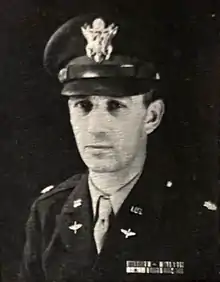Jesse Marcel
Jesse Antoine Marcel Sr. (June 27, 1907 – June 24, 1986) was a Lieutenant Colonel in the United States Air Force who helped administer Operation Crossroads, the 1946 atom bomb tests at the Bikini atoll.[1]

Early life
On May 27, 1907, Jesse Marcel was born to Theodule Joseph Marcel and his wife Adelaide Marie Bergeron Marcel in Bayou Blue, Louisiana.[2] Jesse was youngest of seven siblings. Jesse reportedly harbored an early interest in amateur radio and graduated from Terrebonne High School.[1]
After Marcel graduated from high school, he worked for a General Store, attended a few graphic design classes at Louisiana State University. Marcel began working as a draftsman and cartographer for the Louisiana Highway Department, the Army Corps of Engineers, and the Shell Oil Company.[1]
Military career
In 1924, Marcel began a three-year enlistment in Louisiana National Guard.[1] In June of 1935, Marcel married Viand Aleen Abrams. The following year she gave birth to their first child. In 1936, Marcel undertook another three-year enlistment, this time in the Texas National Guard.[1]
World War II
In March 1942, Marcel was commissioned as a 2nd lieutenant in the US Army Air Force, and in the summer of 1942, Marcel attended the Army Air Force Intelligence School in Harrisburg, Pennsylvania for training as Combat Photo Interpreter/ Intelligence Officer. Upon graduation from the program, Marcel was promoted to the role of instructor.[1]
In October 1943, 1st Lt. Marcel was assigned to the 5th Bomber Command in the Southwest Pacific, serving as Squadron Intelligence Officer and later Group Intelligence Officer. Marcel received two Air Medals and the Bronze Star.[1][3] After a promotion to Captain, in May 1945, Marcel was promoted to the rank of Major.
509th and role in Operation Crossroads

In the mid-1946, Marcel was attached to the 509th Composite Group to prepare for and participate in a series of atomic bomb tests in the Pacific called Operation Crossroads at Bikini Atoll.[1][4][3] They were the first detonations of nuclear devices since the atomic bombing of Nagasaki on August 9, 1945.[5][6]
There were only seven nuclear bombs in existence in July 1946.[7] The two bombs used in the test were Fat Man plutonium implosion-type nuclear weapons of the kind dropped on Nagasaki. The Able bomb was stenciled with the name Gilda and decorated with an Esquire magazine photograph of Rita Hayworth, star of the 1946 movie, Gilda.[8] The Baker bomb was Helen of Bikini.[9]
On 26 July 1946. Brig. General Roger M. Ramey authored a letter of commendation complimenting Marcel's performance during Operation Crossroads.[10] The following month, Marcel received an additional letter of commendation from Maj. Gen. W. E. Kepner for his performance in the operation.[11] In December 1947, Marcel received a promotion to the rank of Lt. Colonel.[3]
Roswell UFO Incident
Marcel was a key figure in the discovery and initial analysis of the Roswell UFO incident.[12] "[We] spent a couple of hours Monday afternoon [July 7] looking for any more parts of the weather device", said Marcel. "We found a few more patches of tinfoil and rubber."[13]
Strategic Air Command
Marcel remained with the 509th at Walker AFB until August 16, 1948, when he was transferred to Strategic Air Command at Andrews AFB. When SAC HQ transferred to Offutt AFB in Nebraska on November 9, 1948, Marcel transferred with it.[3]
Final years and death
After requesting a hardship discharge to care for an elderly mother, in July 1950 Marcel returned to Houma, Louisiana. In September 1950, Marcel was released from active duty and transferred to the Air Force reserves. He received his final discharge in 1958.[3]
In his final years, Marcel was a self-employed television repairman.[3]
Jesse Marcel died in 1986 at the age of 79.[14][1] He was survived by his wife Viaud Abrams Marcel and his son Jesse A. Marcel Jr. M.D.[1]
References
- Marcel, Jesse; Marcel, Linda (January 1, 2008). "The Roswell Legacy: The Untold Story of the First Military Officer at the 1947 Crash Site". Red Wheel/Weiser – via Google Books.
- Korff, Kal K. (November 9, 2000). "The Roswell UFO Crash: What They Don't Want You to Know". Dell – via Google Books.
- Major Jesse Marcel: Folk Hero or Mythomaniac? (Dec 1995) Robert G. Todd
- Randle, Kevin D. "Roswell in the 21st Century". Speaking Volumes – via Google Books.
- "Operation Crossroads". nuclearweaponarchive.org.
- Dockrill, Peter. "The Chilling Story of The 'Demon Core' And The Scientists Who Became Its Victims". ScienceAlert.
- Weisgall 1994, p. 286.
- "Atomic Goddess Revisited: Rita Hayworth's Bomb Image Found". CONELRAD Adjacent (blog). August 13, 2013. Retrieved March 11, 2015.
- Weisgall 1994, pp. 263–265.
- "Ramey Commendation"., 26 July 1946
- "Kepner Commendation"., 16 August 1946
- Weaver, Colonel Richard L.; McAndrew, 1st Lt. James (1995). The Roswell Report: Fact versus Fiction in the New Mexico Desert (PDF). Washington DC: Headquarters United States Air Force. p. 160. Archived (PDF) from the original on 25 June 2019. Retrieved 15 December 2019.
- "New Mexico Rancher's 'Flying Disk' Proves to be Weather Balloon-Kite". Fort Worth Star-Telegram. July 9, 1947. Archived from the original on September 27, 2013. Retrieved February 5, 2013.
- "The truth is out there: Roswell incident recalled by local vet who was there 60 years ago". San Diego Union-Tribune. September 30, 2007.
Sources
- Weisgall, Jonathan (1994). Operation Crossroads: The Atomic Tests at Bikini Atoll. Annapolis, Maryland: Naval Institute Press. ISBN 978-1-55750-919-2.